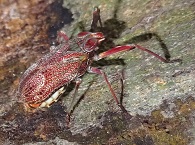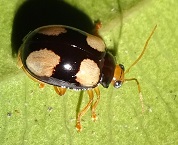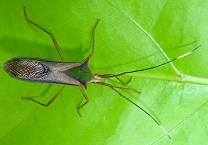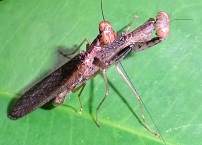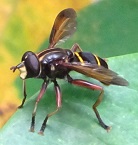| Home | Nature Weekly Index |
4 October 2015 | Field Trip | Upper Seletar Reservoir |
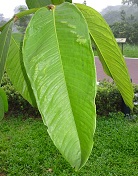
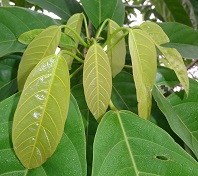 After almost a year, since November 2014, I was back again to the Upper
Seletar Reservoir area yesterday. Though it was a weekend, the human density in the area was relatively light due to the recent hazy
weather condition, which was not conducive for outdoor activities. Even the golf course next door was not having the usual queue at
the start point.
After almost a year, since November 2014, I was back again to the Upper
Seletar Reservoir area yesterday. Though it was a weekend, the human density in the area was relatively light due to the recent hazy
weather condition, which was not conducive for outdoor activities. Even the golf course next door was not having the usual queue at
the start point.
Before proceeding to the reservoir area, I made a short detour to the Springleaf Nature Park nearby. The park was officially opened on 1 November 2014. A new tree that I picked up there was Garcinia nervosa, a tree from the Mangosteen family (Clusiaceae). Its distinctive feature was the large leaves, slightly larger than that from Garcinia griffithii found in our forest. Separately, there were at least 2 trees with the tagged Harpullia ramiflora on the ground in front of them. However, when I checked on the name later, the trees looked more like a Sterculia parviflora with its long leaf stalks. Leaf stalks of Harpullia ramiflora should be very short. The park had several other interesting trees but my destination of the trip was not here. After spending about 30 minutes there, I decided to move on.
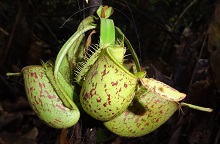
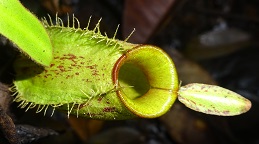
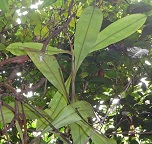 The first 2.5 hours in the forest were uneventful with many of the familiar but unknown plants. Fruiting or flowering plants were
few. I caught sights of several interesting insects but overall, no spectacular discovery. Finally, at around 10:30 am, I saw
vaguely something about 5 metres away from the track, hanging on a stem just a few centimetres above the swampy ground. It took me
a while to realise that it was a pitcher plant as the whole area was cluttered with all kind of leaves and branches, both live and
dead ones, and I did not expect to see one this swampy area. To top up the surprise, it was the last pitcher plant,
Narrow-lidded Pitcher Plant (Nepenthes ampullaria), in the list of 3
available in Singapore that I had been searching for quite a while. I had passed by the area a few times in the past and had
actually noticed the plant with the large leaves but there was no pitcher then. I had thought that it was
Freycinetia javanica, also available in the same area.
The first 2.5 hours in the forest were uneventful with many of the familiar but unknown plants. Fruiting or flowering plants were
few. I caught sights of several interesting insects but overall, no spectacular discovery. Finally, at around 10:30 am, I saw
vaguely something about 5 metres away from the track, hanging on a stem just a few centimetres above the swampy ground. It took me
a while to realise that it was a pitcher plant as the whole area was cluttered with all kind of leaves and branches, both live and
dead ones, and I did not expect to see one this swampy area. To top up the surprise, it was the last pitcher plant,
Narrow-lidded Pitcher Plant (Nepenthes ampullaria), in the list of 3
available in Singapore that I had been searching for quite a while. I had passed by the area a few times in the past and had
actually noticed the plant with the large leaves but there was no pitcher then. I had thought that it was
Freycinetia javanica, also available in the same area.
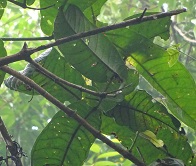
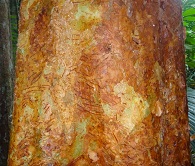
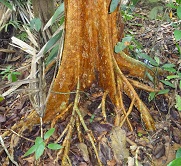 There was a distinctive tree in the swamp area that could not be missed due to its orange trunk that made it stand out from the
other trees with typical light or dark brown trunks. The reason that I had yet to post its pictures on my website until today was
the inability to capture the picture of the leaves, due to the height of the tall tree as well as the crowded canopy in the forest.
I knew its name (Syzygium papillosum) as I had read it from the Flora
Singapura website. To my horror, the website seemed to be gone from the cyberspace when I try to check on the plant today. It was
started by Tony O'Dempsey in 2011 and housed many nice pictures of local native trees found in our forest. Hopefully, it was not closed but was down
due to a temporary glitch. Another good reference of the plants in this area is from the 265-page article
"100 common vascular plants of the nee soon swamp forest, Singapore"
published in 2013 by NUS. Another Syzygium species with orange trunk is
Syzygium antisepticum but this tree is not found in swamp forest.
There was a distinctive tree in the swamp area that could not be missed due to its orange trunk that made it stand out from the
other trees with typical light or dark brown trunks. The reason that I had yet to post its pictures on my website until today was
the inability to capture the picture of the leaves, due to the height of the tall tree as well as the crowded canopy in the forest.
I knew its name (Syzygium papillosum) as I had read it from the Flora
Singapura website. To my horror, the website seemed to be gone from the cyberspace when I try to check on the plant today. It was
started by Tony O'Dempsey in 2011 and housed many nice pictures of local native trees found in our forest. Hopefully, it was not closed but was down
due to a temporary glitch. Another good reference of the plants in this area is from the 265-page article
"100 common vascular plants of the nee soon swamp forest, Singapore"
published in 2013 by NUS. Another Syzygium species with orange trunk is
Syzygium antisepticum but this tree is not found in swamp forest.
On the small insects, below were 5 of the more unusual ones. From left to right: (1) Likely to be a planthopper though it did not hop away but instead crawled along the tree trunk; (2) a leaf beetle with 4 white spots; (3) a squash bug; (4) a pair of mating praying mantis; and (5) a wasp-mimicking hoverfly.
